Please Take Note: This is a review of the final game, but it might change slightly based on the success of the Kickstarter campaign. The game is being reviewed on the components and the rules provided with the understanding that “what you see is not what you might get” when the game is published. If you like what you read and want to learn more, we encourage you to visit the game publisher’s website or visit the Kickstarter campaign. Now that we have all that disclaimer junk out of the way, on with the review.
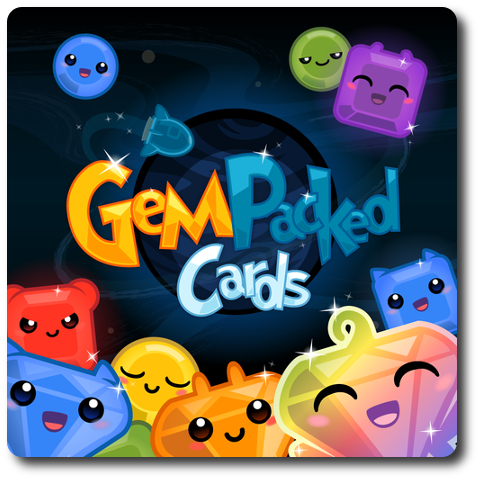
The Basics:
- For ages 6 and up
- For 2 to 5 players
- Approximately 20 minutes to complete
Geek Skills:
- Counting & Math
- Logical & Critical Decision Making
- Pattern/Color Matching
- Strategy & Tactics
- Hand/Resource Management
Learning Curve:
- Child – Easy
- Adult – Easy
Theme & Narrative:
- Mix and match the colors of the rainbow for fun and profit
Endorsements:
- Gamer Geek approved!
- Parent Geek approved!
- Child Geek approved!
Overview
Color can lighten up a room, darken a hallway, communicate feelings, and cause us to pause almost indefinitely when attempting to match the perfect tie with a shirt. Colors can even dictate action, with red telling us to stop, green telling us to go, and yellow urging us to go faster. In this game, mixing colors will allow the player to gain the upper hand, but they can also benefit from breaking colors down to smaller parts for a bigger win.
GemPacked Cards, designed by Eduardo Baraf and to be published by Pencil First Games, will reportedly be comprised of 118 Gemino cards (2 complete decks of 49 cards each and 12 Goal cards) and 100 Gemino Pip tokens. As this is a review of a prepublished game, I cannot comment on the game component quality. The artwork by Katherine Waddell makes heavy use of the Emoji-like characters to bring each gem character to adorable life. Seriously. They are so adorably sweet that looking at the cards for too long will result in a cavity…or worse.
Game Set Up
Note: GemPacked Cards can be played by 2 to 5 players, but the game set up is different depending on the number of players at the table. The game set up steps summarized here are for 2 to 3 players. See “Game Variants” for a summary on how to set up the game for 4 to 5 players.
To set up the game, first separate the cards into three different piles. One pile for the Gemino cards (card backs will have colored corners), the Goal cards (card backs will have a rocket ship), and any remaining cards. Separate the Gemino pile of cards one more time by card corner color, resulting in a gold-corner and blue-corner Gemino decks. Place the remaining cards aside.
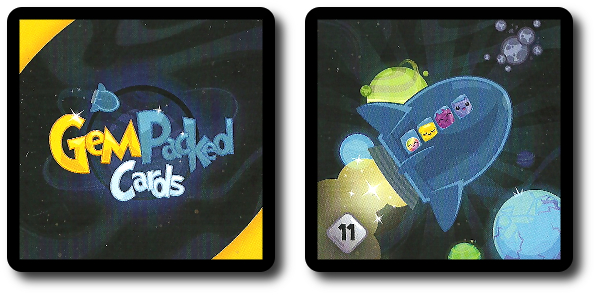
Example of card backs
Second, shuffle the gold-cornered Gemino deck and deal 9 out to the table face-up to form a 3×3 square grid. If an “Action” Gemino card is revealed, place it aside and draw a new card. If more than 3 “Diamond” Gemino cards are dealt, set aside the excesses and continue dealing cards. When the square grid is complete, take any gold-cornered Gemino cards that were set aside and reshuffle the gold-corner Gemino deck. Place this deck face-down to one side of the square grid. This is the draw deck for the duration of the game. The Gemino cards with the blue-corners is not used in a 2 and 3-player game. Place them back in the game box.
Third, shuffle the Goal cards and deal, face-up, one more card than the number of players in the game. For example, if you are playing a 3-player game, you would deal 4 Goal cards. Deal the Goal cards in a row next to the draw deck.
Fourth, if only playing with 2 players, place the Sun card and the Nova card below the row of Goal cards. If playing with 3 players, include the Red Dwarf card, as well. These cards are not part of the Goal or the Gemino decks.
Fifth, separate the Gemino Pip tokens into 2 piles. One pile for blue-backed tokens and 1 pile for gold-backed tokens. Set the blue-backed tokens aside. Place the gold-backed tokens in the bag or a bowl and mix them around. The blue-backed Gemino Pip tokens are not used in a 2 and 3-player game. Place them back in the game box.
That’s it for game set up. Decide who will be the first player and begin.
Glam and Glimmer
GemPacked Cards is played in turns. On a player’s turn, they will complete a small number of sequential steps which are summarized here.
- All cards collected by a player are kept in front of them, face-up. This is the player’s hand.
- Gemino Pip tokens the player owns go in front of them. Pips used to buy cards go to a Pip Pool, not back to the bag or bowl. The Pip Pool starts empty. Players will dip into the Pip Pool when selling “Square” Gemino cards.
Step 1: Draw Gemino Pip Tokens and Possibly Refresh the Grid
The first thing a player does on their turn is draw 2 Gemino Pip tokens from the bag and place them face-up in front of them.
If the grid has 7 ore more “Diamond” Gemino cards in it, the player can refresh the grid if they so choose. If they decide to refresh the grid, all the cards in it are discarded and new cards are dealt. If an “Action” Gemino card is dealt, it’s ignored and discarded.
Step 2: Take Actions
The player can now take as many actions as they like and in any order they choose, as long as they can pay the cost for the action. The possible actions are as follows:
Buy 1 “Square” Gemini Card from the Grid
If a “Square” Gemino card is in the grid, it can be purchased. A “Square” Gemino card must be purchased using the Gemino Pip tokens. The cost of the “Square” Gemino card is always 2 Gemino Pip tokens. The primary color “Square” Gemino cards (blue, red, and yellow) must be purchased using 2 Gemino Pip tokens of the same color as the square. Purple, orange, and green “Square” Gemino cards can be purchased using 2 Gemino Pip tokens of the same color or 2 different colored Gemino Pip tokens that would create the “Square” color when combined.
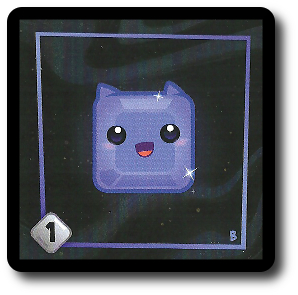

Buy 1 “Diamond” Gemino Card from the Grid
If a “Diamond” Gemino card is in the grid, it can be purchased. A “Diamond” Gemino card must be purchased using the “Square” Gemino cards. The cost of the “Diamond” Gemino card is always 2 “Square” Gemino cards. The primary color “Diamond” Gemino cards (blue, red, and yellow) must be purchased using 2 “Square” Gemino cards of the same color as the diamond. Purple, orange, and green “Diamond” Gemino cards can be purchased using 2 “Square” Gemino cards of the same color or 2 different colored “Square” Gemino cards that would create the color of the “Diamond” when combined.
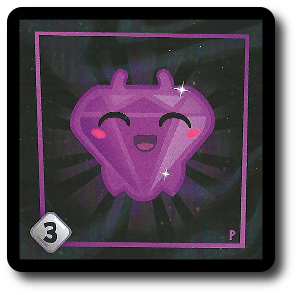

Sell 1 “Square” Gemino Card for Pips
This is the reverse of buying a “Square” Gemino card. The player discards the “Square” Gemino card and then collects 2 Gemino Pip tokens that would make the card’s color, adding it to their own personal pile. The Pips are taken from the Pip Pool, never from the bag.
Buy the Sun, Red Dwarf, Nova, or Goal Cards
If the listed cards are available, the player can purchase them by using Gemino Pip tokens and “Square” Gemino cards. But be quick! These cards are rare and can only be purchased once per game. Once purchased, they are placed in the player’s hand and turned face-down.

During the course of the game, players might collect “Wild” Gemino Pip tokens and Gemino cards. These special resources can be used to represent any color when taking the buying action. When selling, “Wild” Gemino cards becomes a color of the player’s choice and they then collect the appropriate “Square” Gemino cards or Gemino Pip tokens.
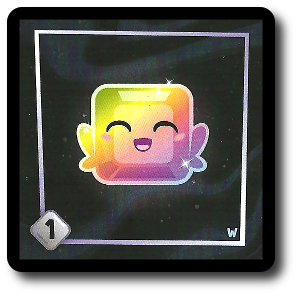

Step 3: All Done
If the player is unable to buy a card and unwilling to sell a card, they draw 1 Gemino Pip token from the bag, adding it to their pile.
Step 4: Refill
The player’s turn is now over. Before the next player in turn order sequence goes, the grid is refilled with cards from the draw deck. If the draw deck is empty, shuffle the discard pile to create a new draw deck.
It’s possible that an “Action” Geronimo card will be drawn. These cards are immediately resolved starting with the current player and continuing in turn order sequence. The “Action” Gemino card is then discarded.
The “Action” Gemino cards are as follows:
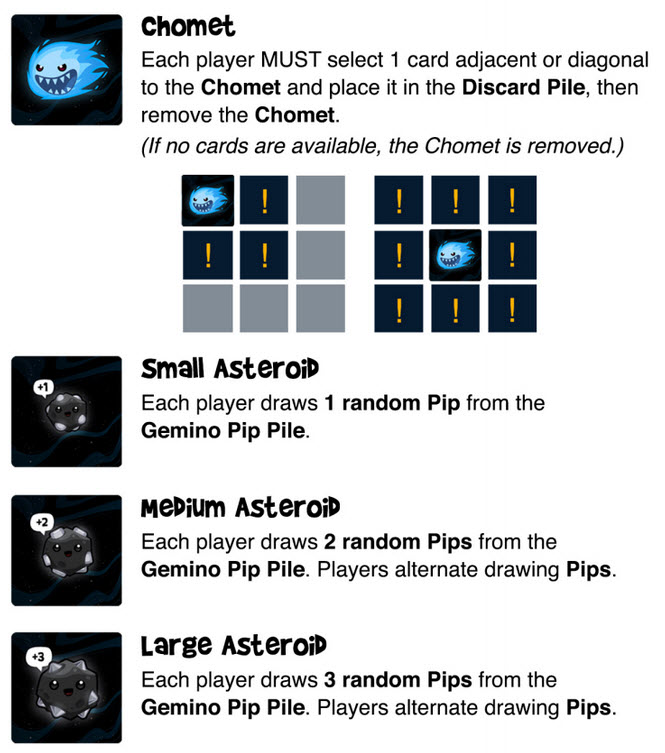
When the grid is full, the player’s turn is over and the next player takes their turn. This continues until the game comes to an end.
The End of the Rainbow
The endgame is triggered when the last Gemino Pip from the bag is drawn. All players are given 1 last turn and then points are scored.
Players then place all their collected cards in front of them. The number of points each is worth is listed on the card. The player with the most points wins the game. Ties are resolved by counting the number of Gemino Pips, with victory going to the player with the most.
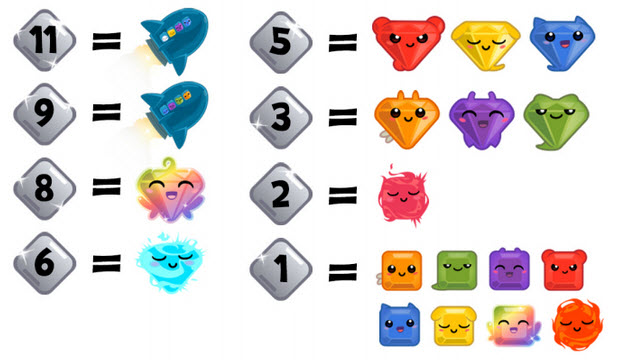
Game Variants
GemPacked Cards for 4 to 5 Players
While the game play is the same for all, the game set up for a 4 and 5-player game is slightly different. Both the gold-cornered and blue-cornered cards are used and a 4×3 rectangle grid, not a square grid, is created during game set up. Since there are more players, additional Sun, Nova, and Red Dwarf cards are put into play. The number of Gemino Pip tokens is also increased with random blue-backed Gemino Pip tokens being added to the mix. Finally, if the rectangle grid should ever have 9 “Diamond” Gemino cards (not 7), a player can decide refresh it.
Advanced Play
GemPacked Cards can be a challenging game, but if players think they are ready for an even bigger challenge, the game can oblige. The game is played 3 times in a row with the winner of the game being the player who has the most points overall. But it isn’t as simple as it sounds. During the first game, the standard rules apply. During the second game, place the first drawn Gemino Pip face down and the second face-up. During the third and final game, all drawn Gemino Pips are kept face-down and any cards in the player’s hand are kept face-down, as well. As the game progresses, players will know less and less about how well their opponents are doing.
Going Digital
GemPacked Cards is the analog version of GemPacked, a video game available for smartphones and tablets. If you have an iPhone or iPad, you can enjoy the game away from the table.
To learn more about GemPacked, visit the game publisher’s website or visit the Kickstarter campaign.
Final Word
GemPacked Cards was a game the Child Geeks gravitated to naturally. Be it the bright colors, the happy expressions on the gems, or the fact that the illustrations are strikingly similar to what you’d find in a video game, the Child Geeks all sat down to learn GemPacked Cards with genuine interest. When I asked one Child Geek why she wanted to play, she responded, “The characters look really cute and the colors are pretty. I think I found my new favorite game!” When I asked a young gentleman, he said, “Reminds me of the games I play on the iPad.” Regardless of what drew them to the game, all the Child Geeks who played it quickly learned the rules and got down to business. The only hiccup each player had was initially learning how the colors were combined and broken down. I only ever had to tell them once, however, as the color matching is very intuitive. According to one Child Geek, “This is a lot harder game than it first appears. You have to really think about what you want and then trade up or down to get it.” Another Child Geek said, “There’s more than one way to win the game, but the most important thing a player can do is always buy the most expensive the quickest way possible.” Note that he didn’t say “cheapest”, as the “price” of buying a card is fixed. What a player needs to do is become very efficient with their color builds and breakdowns so they can get the best cards first. When all the games were over, the Child Geeks unanimously agreed to approve GemPacked Cards.

The trading for colors was always an intense and exciting time, for the player and their opponents
The Parent Geeks were also pleased with the game, finding it to be an excellent exercise in critical and logical thinking, not to mention the surprisingly deep level of strategy that lies just below the cute little characters on the cards. According to one Parent Geek, “This game really surprised me. I thought it was going to be little more than trading cards, but there is a lot more to it.” Much more, indeed. The game is very simple in its presentation, but players will quickly realize how involved some of the transactions and resource management can be during a single game. As one Parent Geek put it, “I wouldn’t go so far as to say this is a difficult game, but a player must become very involved in the game play. I can’t tell if this is a resource management game or an economy game. Feels like both and it plays great.” Parent Geeks enjoyed GemPacked Cards with their families and their peers, making it easy for them to unanimously agree to approve the game.
The Gamer Geeks jumped all over this one, but not in a good way. They sat down and sneered at the colorful cards, laughed unkindly at the cute little faces, and made many a nasty joke. After playing a single game, their sneers turned to smiles, their unkind laughter was replaced with cheers of excitements, and their jokes…well…their jokes are always nasty. Despite their best efforts, the Gamer Geeks actually enjoyed GemPacked Cards. According to one Gamer Geek, “Don’t get me wrong, this is a light game, but it’s also a game that requires some serious thought. I really like how the designer captured the complexity of trading up and down, mixing and matching, in a way that is so easy to teach and play.” Another Gamer Geek said, “The game looks light, plays heavy, and is highly entertaining. I’d play this again.” All the Gamer Geeks agreed that GemPacked Cards was not a game they would want to make the center piece of their elitists table, but they also all agreed that GemPacked Cards was a game well worth their time, either as a filler or just to play when a good game with depth and strategy was needed, but their was little time to play. All the Gamer Geeks approved GemPacked Cards.
GemPacked Cards really is a gem of a game. It’s simple, but complex. Breezy, but deep. I liken it to a glass of wine that is easy enough to sip, but the taste is complex, rich, and warm with notes of surprising ingredients you didn’t see coming. This is not a game that is difficult to learn, but it can be very difficult to win. A player is continually challenged to make choices that feel easy, but are really very important. If a player is to be competitive, they must have a plan as soon as they sit at the table and then the ability to quickly alter that plan without getting lost in the sparkly gem-like details. None of this is communicated by the colorful, happy cards, and at no time will a player feel like they are engaged in a desperate exercise. That’s because the game plays that well. It’s all there for the player, encouraging them, giving them options, and best of all, making them think in a fun way.
Now that’s a neat game.
I would recommend GemPacked Cards for families, for casual gamers, for non-gamers, for those looking for a deep game with a light attitude, for elitists players who want to play a light game that reduces none of its challenging game play, and for anyone who can’t get enough of cute little gems. GemPacked Cards is a good time, colorful, creative, and challenging. Do play this game when you get a chance.
This is a paid for review of the game’s final prototype. Although our time and focus was financially compensated, our words are our own. We’d need at least 10 million dollars before we started saying what other people wanted. Such is the statuesque and legendary integrity of Father Geek which cannot be bought except by those who own their own private islands and small countries.



